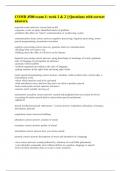Exam (elaborations)
COMD 4500 exam 1: week 1 & 2 || Questions with correct answers.
- Course
- Institution
acquired correct answers -occurs later in life -exposure, event, or injury-identified source of problem -problems that affect an "intact" communication or swallowing system communication chain correct answers cognitive processing, linguistic processing, motor speech programming, neuromotor exe...
[Show more]



